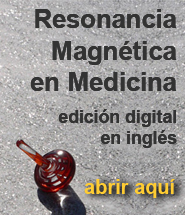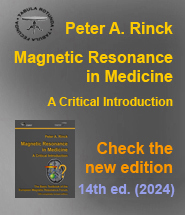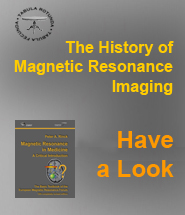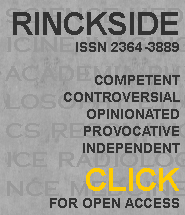16-03 Posproceso de los estudios dinámicos
Durante mucho tiempo, uno de los principales objetivos de los investigadores era lograr la mejora de contraste de las imágenes de RM por medio de posibles agentes de contraste electrónicos, sin la utilización de medios de contraste exógenos. Los primeros objetivos de este tipo de procesado de imágenes de RM se centraron en obtener imágenes de los tiempos de relajación y, en una fase posterior, imágenes segmentadas.
Sin embargo, este concepto de la existencia de agentes de contraste electrónicos que se pueden emplear para realzar patologías a través del procesamiento de imagen deriva de una hipótesis incorrecta, que sostiene que hay información oculta sobre los tejidos o los procesos en las imágenes originales o los datos brutos. La información adicional proporcionada por un agente de contraste exógeno, como la vascularización, la permeabilidad de las membranas, etc., no la proporciona ninguna modalidad de imagen normal y por lo tanto no puede ser realzada electrónicamente. En otras palabras, si la relación de contraste-a-ruido es cero en los datos brutos, no se puede mejorar el contraste con técnicas de posproceso de imagen.
Por otra parte, sí es posible realzar la contribución de pequeñas cantidades de contraste en los tejidos con las técnicas de posproceso adecuadas.
Puesto que el patrón de captación temporal de los agentes de contraste in vivo puede variar entre tejido sano y enfermo, las diferencias en captación pueden ser de valor diagnóstico. En las curvas de señal de intensidad frente a tiempo, algunas lesiones presentan pendientes más pronunciadas, mayor intensidad de señal máxima y un lavado más rápido del agente de contraste que el tejido circundante [⇒ Gribbestad, ⇒ Kaiser, ⇒ Tofts 1991].
Un factor que contribuye a la incertidumbre de los datos cuantitativos medidos sobre imágenes dinámicas es la gran dispersión de los valores de volumen sanguíneo y tiempo de tránsito entre diferentes órganos, o incluso dentro de estructuras similares. En el cerebro, los valores de volumen sanguíneo y tiempo de tránsito tienden a ser más altos en el puente troncoencefálico, el cerebelo y el bulbo raquídeo que en las partes media y anterior, lo que sugiere algunas diferencias generales regionales en la microvasculatura [⇒ Nakagawa]. Estas diferencias pueden ser sustanciales y llegar a solaparse con los valores de patologías. El conocimiento adecuado de los rangos de normalidad de la anatomía y la fisiología es esencial para la evaluación final de los datos calculados y de las imágenes paramétricas.
La imagen dinámica digital se desarrolló para medicina nuclear y TC como complemento y sustitución de la fluoroscopia analógica, destacando así los factores de contraste adicionales. Las exploraciones dinámicas con PET para mediciones del flujo sanguíneo cerebral regional, por ejemplo, se pueden realizar a intervalos de varios segundos. Sin embargo, los métodos basados en radioisótopos carecen de una buena resolución temporal y espacial, mientras que la TC es rápida y muestra estructuras anatómicas en detalle.
Conventional MR imaging is a slow imaging technique. All of the classical imaging sequences have long examination times. Only in the late 1980s did rapid imaging pulse sequences become available. They made it possible to follow the dynamic signal-intensity changes after contrast injection (Figure 16-05).

|
Figura 16-05:
Graphic depiction of the time scale of different events in man versus MR imaging methods. Imaging speed must be 3-10 times faster than the event to be monitored or avoided.
* = of contrast agent.
The prerequisite of sufficient spatial and time resolution was given with rapid imaging, and the uptake of contrast agents could be readily monitored by MR imaging (cf. bolus injection in CE-MRA).
Maximum vascular concentration of an ECF-space contrast agent will occur during the first pass through the body in the vascular phase. Maximum tissue concentration, as well as enhancement rate and onset, depend on a number of not yet completely understood factors such as vascularity, membrane permeability, and leakage of the blood-brain or the tumor barrier, and venous outflow.
Thus, maximal tissue concentration may occur between several seconds and minutes after the injection of the contrast agent (Figure 16-06). The agent then diffuses into the extracellular space until an equilibrium is reached during the plateau phase. Concentration decreases during the wash-out phase which follows. The enhancement processes can be monitored by time-intensity curves. Although both the vascular and the extracellular phase of uptake go hand in hand, one must distinguish monitoring the dynamic signal-intensity changes of the first pass of a contrast agent bolus such as in brain and heart imaging and the slower tissue uptake as it is commonly done in breast lesions.
 |
|
Figura 16-06: |
Image registration of contrast-enhanced images of non-rigid organs is a difficult problem due to the changes not only in contrast but also in the structures visible. Whereas rigid organs like the brain can be aligned by performing translations and rotations, non-rigid organs require non-rigid reformations that potentially can change the structures to be observed.
An additional problem is the propagation of mistakes, e.g., through artifacts which are not recognizable any more on processed images. They can be caused by a change of relative or absolute signal intensity on the image influenced by outside factors such as surface coils.
Furthermore, due to the frequent presence of time constraints, the signal-to-noise ratio is often quite low in dynamic contrast-enhanced MR imaging. This necessitates the need for noise-reduction techniques [⇒ Sebastiani] which are commonly performed by applying so-called filters either in the spatial (image) or in the temporal domain.
There are some very sophisticated filters which can remove noise in a way which was previously only possible by increasing the magnetic field strength or improvements in the amplifiers or other hardware.
The time resolution required to study the dynamics of the contrast agent uptake in an organ depends on the requirements of the individual investigation. Better time resolution will improve the characterization of the bolus while passing through the body region-of-interest, in particular if these images are to be treated by mathematical techniques to analyze bolus behavior [⇒ Jones].
Such mathematical treatment which can lead to parametric images is beyond the capability of the human brain, which is unable to make a correlation if the number of features exceeds three. The differences can be distinguished either by a qualitative description of the change in signal intensity observed over time or by quantification of certain parameters by fitting the concentration-time course to a pharmacokinetic model [⇒ Larsson, ⇒ Tofts 1991 + 1995].
Explanations of the parameters are shown in Figure 16-07, and an overview of qualitative or semi-quantitative parameters commonly determined by time versus intensity curves is given in Table 16-02.
 |
|
Figura 16-07: |

|
Tabla 16-02:
Some parameters in dynamic imaging. Note: there is no general agreement on terms and nomenclature – and there is no agreement on the diagnostic implication of these parameters.
In this context, it is important to remember that MR imaging has no standard units for signal intensity. It cannot be measured in units comparable to Hounsfield units in CT. Several attempts have been made to create a quantitative scale, but none of these methods creates an absolute standard.
Thus, signal intensity-versus-time curves remain only qualitative representations of contrast passage through tissues. To acquire quantitative data, concentration versus time curves have to be fitted by the principles of tracer dilution kinetics. Time-intensity curves of bolus injections have to be corrected, i.e., cleaned of the influence of recirculation to achieve better raw data for parameter calculation, e.g., by gamma-variate fitting [⇒ Gonzalez, ⇒ Sebastiani, ⇒ Thompson].
The concentration (C) of the contrast agent in each pixel, at each time point, can be calculated from the known relaxivity of the contrast agent and the respective relaxation times, T1 and T10:
C = (R1 - R10) / r1
where R1 = 1/T1 at the measured point during the dynamic study, R10 = 1/T10 prior to injection, and r1 is the longitudinal relaxivity of the contrast agent at the given magnetic field strength and 37° C.
The resulting concentration-time curves can be fitted to pharmacokinetic models [⇒ Thompson]. From this, values of permeability and leakage volume are derived. For extended image-processing and data analysis, independent software systems running on personal computers have been developed. A number of software systems offer an integrated, standardized way of performing both image-processing and image analysis on all kinds of dynamic images independent of the imaging equipment on which the images were acquired in a standardized way [⇒ Torheim 1997 + 1999].












